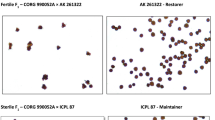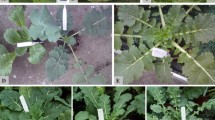Abstract
Exploitation of hybrid vigour is quite possible in cross-pollinated crops. However, pigeonpea is a grain legume crop with a moderate level of cross-pollination (20–70%), which is mainly aided by insect pollinators. As a first step, hybrids based on genetic male sterility (GMS) were developed in pigeonpea, but the hybrid seed production technique is not farmer-friendly, because in the hybrid seed production plot 50% of the population, which are male-fertile in the female rows, have to be eliminated in time before contamination. This requires skilled labour and is a time-consuming process, which increases the cost of hybrid seed production. Therefore, the objective of this study was to develop cytoplasmic-genetic male-sterile (CGMS) lines in pigeonpea through wide hybridization, which would be very suitable for hybrid seed production. Two CGMS lines, viz. CORG 990052 A and CORG 990047, were developed by interspecific hybridization ofCajanus cajan andC. scarabaeoides. Restorers were identified and three CGMS-based pigeonpea hybrids were developed. The hybrid COPH 3 is found to be promising in Tamil Nadu State, India.
Similar content being viewed by others
References
Ariyanayagam RP, Rao AN, Zaveri PP, 1995. Cytoplasmic genetic male sterility in interspecific matings inCajanus. Crop Sci 35: 981–985.
Bhatia K, Gupta SC, Green JM, Sharma D, 1981. Estimates of natural cross pollination inCajanus cajan (Lr) Millsp.: several experimental approaches. In: Proceedings of International Workshop on Pigeonpea, Vol. 2, 15–19 December 1980, ICRISAT, Patancheru, AP, India: 129–136.
Kalaimagal T, Muthiah AR, 2004. Hybrid seed production of the redgram hybrid COPH 2. In: Proceedings of National Seminar on Hybrid Breeding in Crop Plants. Annamalai University,3–4 March 2004, Chidambaram: 62.
Khan TN, 1973. A new approach to the breeding of pigeonpea (Cajanus cajan (L.). Millsp.): formation of composites. Euphytica 22: 373–377.
Mallikarjuna N, Saxena KB, 2002. Production of hybrids betweenCajanus acutifolius andCajan cajan. Euphytica 124: 107–110.
Mallikarjuna N, Saxena KB, 2005. A new cytoplasmic nuclear male sterility derived from cultivated pigeonpea. Cytoplasm. Euphytica 142: 143–148.
Muthiah AR, Kalaimagal T, Sassikumar D, 1998. Cost of seed production: redgram hybrid COPH 2. Legume Research 21: 65–66.
Onim JFM, 1981. Pigeonpea improvement research in Kenya. In: Proceedings of the International Workshop on Pigeonpeas. Vol. I. 15–19 December 1980, Int Crop Res Inst for the Semi-Arid Tropics, Patancheru, AP, India: 427–436.
Pandey LB, Guruprasad S, Saxena KB, Brent E, 2005. Exploitation of commercial heterosis in pigeonpea (Cajanus cajan (L.). Millsp.). In: Proceedings of the 4th International Food Legume Research Conference for Nutritional Security. 15–19 October 2005, Indian Agric Res Inst, New Delhi: 44.
Rathnaswamy R, Yolanda JL, Kalaimagal T, Suryakumar M, Sassikumar D, 1998a. Cytoplasmic genetic male sterility in pigeonpea (Cajanus cajan (L.). Millsp.). Indian J Agric Sci 69: 159–160
Rathnaswamy R, Yolanda JL, Kalaimagal T, Suryakumar M, Sassikumar D, 1998b. Effect of planting ratio on hybrid seed yield of pigeonpea hybrid COPH 2. Seed Res 26: 92–99
Rathnaswamy R, Ravikesavan R, Kalaimagal T, Rangaswamy M, 1996. COPH 1: the first pigeonpea hybrid for Tamil Nadu. Madras Agric J 83: 314–315.
Rathnaswamy R, Kalaimagal T, Ravikesavan R, Balamurugan GR, Devanand PS, Muthiah AR et al. 1997. High yielding redgram hybrid COPH 2. Madras Agric J 84: 162–163.
Reddy LJ, Faris DG, 1981. A cytoplasmic genetic male-sterile line in pigeonpea. Int Pigeonpea Newsletter 1: 16–17.
Reddy BVS, Green JM, Bisen SS, 1978. Genetic male-sterility in pigeonpea. Crop Sci 18: 362–364.
Saxena KB, 2001. Heterosis breeding in pulses — problems and prospects. In: Proceedings of National Symposium on Pulses for Sustainable Agriculture and Nutritional Security, 17–19 April 2001, New Delhi: 61–72.
Saxena KB, Byth DE, Waliis ES, De Lacy IH, 1981. Genetic analysis of a diallel cross of earlyflowering pigeonpea lines. In: Proceedings of International Workshop on Pigeonpeas, Vol. 2, 15–19 December 1980, Int Crop Res Inst for the Semi-Arid Tropics, India. Patancheru, AP, India: 92.
Saxena KB, Kumar RV, Dalvi AV, Mallikarjuna N, Gowda CLL, Singh BB et al. 2005a. Hybrid breeding in grain legumes. In: Proceedings of 4th International Food Legume Research Conference for Nutritional Security. 15–19 October 2005, Indian Agric Res Inst, New Delhi: 7–8.
Saxena KB, Kumar RV, Madhavi Latha K, Dalvi VA, 2006. Commercial pigeonpea hybrids are just a few steps away. Indian J Pulses Res 19: 7–16.
Saxena KB, Kumar RV, Srivastava N, Shiying B, 2005b. A Cytoplasmic genic male sterility system derived from a cross betweenCajanus cajanifolius andCajanus cajan. Euphytica 145: 291–296
Saxena KB, Srivastava DP, Tikka SBS, 1998. Breaking yield barrier in pigeonpea through hybrid breeding. In: Proceedings of National Symposium on Biotic and Abiotic Stress of Pulse Crops. 26–28 June 1998, Indian Inst Pulses Res, Kanpur: 55–64.
Saxena KB, Wallis ES, Byth DE, 1983. A new gene for male sterility in pigeonpea (Cajanus cajan (L.). Millsp.). Heredity 51: 419–421.
Sharma D, Saxena KB, 2003. Hybrid pigeonpea — a reality. In: Proceedings of National Symposium on Pulses for any Diversification and Natural Resource Management, 20–22 December 2003, Indian Inst Pulses Res, Kanpur: 33–40.
Sharma HK, Laxman S, Sharma D, 1973. Genetic analysis of flower initiation in pigeonpea. Indian J Genet Plant Breed 33: 393–397.
Solomon S, Argikar GP, Solanki HS, Morbad JR, 1957. A study of heterosis inCajan cajan L. Millsp. Indian J Genet Plant Breed 17: 90–95.
Tikka SBS, Parmer LD, Chauhan RM, 1997. First record of cytoplasmic genetic male sterility in pigeonpea (Cajanus cajan (L.). Millsp.). through wide hybridization. Gujarat Agric Univ Res J 22: 60–162.
Wanjari KB, Patil AN, Manapure P, Manjayya JG, Manish P, 2001. Cytoplasmic male sterility in pigeonpea with cytoplasm fromCajanus volubilis. Ann Plant Physiol 13: 170–174.
Author information
Authors and Affiliations
Corresponding author
Rights and permissions
About this article
Cite this article
Kalaimagal, T., Muthaiah, A., Rajarathinam, S. et al. Development of new cytoplasmic-genetic male-sterile lines in pigeonpea from crosses betweenCajanus cajan (L. Millsp. andC. scarabaeoides (L.) Thouars. J Appl Genet 49, 221–227 (2008). https://doi.org/10.1007/BF03195617
Received:
Accepted:
Issue Date:
DOI: https://doi.org/10.1007/BF03195617




